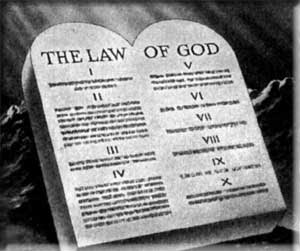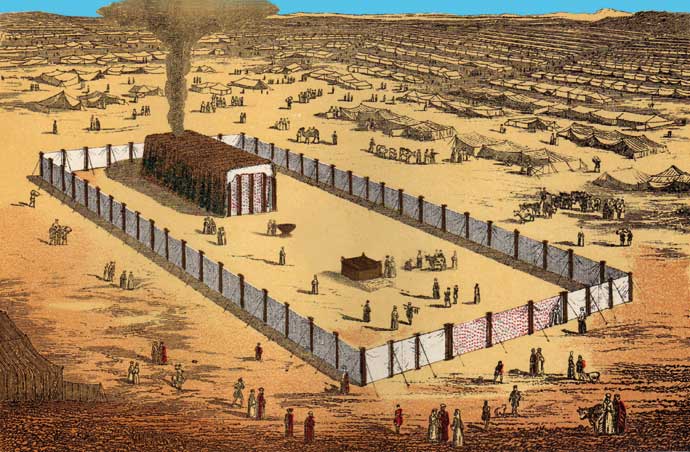If you are familiar with the Tabernacle, you will understand that this brief study is nearing its conclusion at this basic level. Hopefully, for all of us, we will not be content to just complete the Introductory 101 course and never bother to delve deeper into the typical teaching and applications from The Tabernacle.
As Christian learners, we have the privilege of going where no Jew, except for the High Priest, was able to go – not even the regular priests who spent their lives in Tabernacle service. We are now behind that unique curtain that separated the Holy Place from the Holy of Holies. We are winding down this study where God actually started – not finished. We have approached the study as a Jewish worshiper in the camp. When commissioning the ‘project’, God started right here – with the Ark. In fact, everything else we have studied was designed and constructed with a view to housing this very sacred piece of furniture, so God could dwell among His people. God started here:
Have the people make an Ark of acacia wood–a sacred chest 45 inches long, 27 inches wide, and 27 inches high. Overlay it inside and outside with pure gold, and run a molding of gold all around it. Cast four gold rings and attach them to its four feet, two rings on each side. Make poles from acacia wood, and overlay them with gold. Insert the poles into the rings at the sides of the Ark to carry it. These carrying poles must stay inside the rings; never remove them. When the Ark is finished, place inside it the stone tablets inscribed with the terms of the covenant,which I will give to you. Exodus 25:10-16NLT
 When you are reading your Bible, you will notice this piece of furniture is called by different names. Hopefully, you have a Bible Program on your device that allows you to search words and phrases. Plug in the word ‘ark’ and scroll through the results. You will find it interesting. Of course, you will want to distinguish between the ark that Noah built and the ark into which baby Moses was placed – from the ark which we are studying now. Actually, the chest in which they placed the remains of Joseph is the same Hebrew word as the Ark we are studying.
When you are reading your Bible, you will notice this piece of furniture is called by different names. Hopefully, you have a Bible Program on your device that allows you to search words and phrases. Plug in the word ‘ark’ and scroll through the results. You will find it interesting. Of course, you will want to distinguish between the ark that Noah built and the ark into which baby Moses was placed – from the ark which we are studying now. Actually, the chest in which they placed the remains of Joseph is the same Hebrew word as the Ark we are studying.

The Ark of the Covenant was a two-piece unit – the ark (the chest/box) and the Mercy Seat, which will be the focus of Lesson #18. There are so many ways you can study the ark. Its travels, as traced through the Old Testament, is a fascinating study. That’s next week – Lesson #17. It is found, between Exodus and 2 Chronicles – multiple times, with the exception of the Book of Ruth. Also, it pops up in Psalms 132:8 and in Jeremiah 3. Finally, the Ark was housed in Solomon’s Temple until the Temple itself was destroyed in 586 BC. It has never been seen since. In fact, when the veil in Herod’s Temple in Jerusalem was torn in two the day Jesus died – the Holy of Holies was empty.
With that intro, read the verses above again. Based on the measurements given – it was definitely not a huge chest. (45” long, 27” wide, 27” high)
Acacia wood was the prescribed wood once again. If you were to read the Septuagint (which is the Greek version of the Hebrew Old Testament), acacia wood is translated ‘incorruptible wood’. Doesn’t that beautifully describe the humanity of Christ! A wood that could weather the storms and extremes of travelling through a desert wilderness. A.J. Higgins writes: “No unseen rot beneath the surface ever attacked this wood. No hollowness ever afflicted it.” (1) Broken humanity often looks good on the surface, but just a scratch below is nothing but the rottenness of sin. Perfect humanity was seen in Jesus.
The ark was lined with gold – inside and out. The unseen and the visible aspects of the ark were totally plated with gold. What amazing worth and value! The deity of Christ shines through as you read the Gospel. (Acts 2:22, Acts 10:38)
Around the top of the ark, there was a crown or moulding of gold. This perimeter gold ledge would hold the Mercy Seat securely in its place. We haven’t studied the blood-sprinkled mercy seat yet and the propitiatory work, but enjoy this: “the security of the propitiatory work was dependent on the gold of that perimeter crown. It is because of who Christ is that God is satisfied with His work and that we are secure. Touch the Deity of Christ, and you touch the finality of the work of atonement.” (2)

Inside the rectangle chest, the stone tablets of the Law of God (Ten Commandments) given to Moses were placed. Yes, the will of God on the stone tables was inside the gold-lined ark. It’s hard to read Psalm 40:6-8 and not think of the Lord Jesus. Broken humanity could never keep the Law – but Perfect Humanity did! The Law could only be preserved and kept in Christ. It was in His heart, and He delighted only to do His Father’s will. (John 4:34, John 8:29, Hebrews 10:7-9)
You can delve deeper into the contents of the Ark by checking out 1Kings 8:9 and Hebrews 9:4. Here in Exodus, at the start, we are just told the Law of God was placed inside. A. J. Higgins observes: “Later it would contain the pot of manna and Aaron’s rod that had budded. All three were reminders of failure: the golden calf marked the failure of the people when The Law was given. The Golden Pot marked their failure to trust God for bread. The presence of Aaron’s rod would be a reminder of their rebellion at the time of Korah. Yet, all three were under the mercy seat, covered by the blood.” (3)
As we conclude this lesson, take a moment to lift your heart in praise and thankfulness to the Lord – for the rich beauties and colourful perfections of your Saviour and Lord Jesus Christ – as seen through the prism of the ancient tabernacle and its furnishings.
Sources:
- A. J. Higgins, Monday Meditations
- ibid
- ibid

